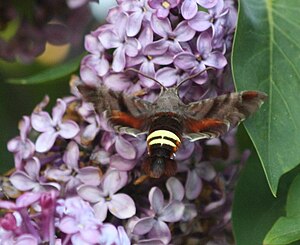Amphion floridensis
| Amphion floridensis | ||||||||||||
|---|---|---|---|---|---|---|---|---|---|---|---|---|

Amphion floridensis the flowers visit |
||||||||||||
| Systematics | ||||||||||||
|
||||||||||||
| Scientific name of the genus | ||||||||||||
| Amphion | ||||||||||||
| Huebner , [1819] | ||||||||||||
| Scientific name of the species | ||||||||||||
| Amphion floridensis | ||||||||||||
| Clark , 1920 |
Amphion floridensis is the only butterfly species of the genus Amphion from the family of swarmers (Sphingidae).
features
butterfly
The moths have a fore wing length of 22 to 24 millimeters. The outer edge of the forewing is grooved, the abdomen has a pair of bright yellow stripes and the end of the abdomen is provided with a tuft of scales. These characteristics make the species distinctive. The hind wings are variably colored orange-yellow in the middle field. Males and females have the same coloring and markings, but can be easily distinguished by the tuft of scales at the end of the abdomen: in females, the tuft ends with a straight to slightly concave edge, in males with three clearly recognizable lobes. Because of its wing shape, the species is somewhat similar to species of the genus Sphecodina , but its abdomen is rounded at the end and it lacks the lateral scale tufts on the last four abdomen segments.
Caterpillars
Adult caterpillars have a rust-brown basic color and are dotted with pale yellowish-white dots. The side of the animal's body is brightly colored and provided with a series of dark brown diagonal stripes. The anal horn is short and strongly curved backwards.
Dolls
The doll is dark brown and has a slightly rough surface. The trunk sheath is fused with the body. The abdomen segments are significantly narrower and taper more towards the rear than in other hawk species. The somewhat elongated Kremaster is rough and ends in a double point.
Occurrence
The species has been found in the United States in all states east of the Mississippi and in the states bordering it to the west. It is less common in the Great Plains , but occurs west to Alpine , as far as the Colorado lowlands and the hill country of northwestern Nebraska. In Canada it is found in Nova Scotia, New Brunswick, in southern Quebec, in Ontario on the Niagara Peninsula , north to Matachewan and west to Rainy River and in the southeast of Manitoba. The species is absent in Saskatchewan and the bordering US states of North Dakota and Montana, but a stray visitor is known from southwest Alberta. The edges of the forest and adjacent fields are populated with grapevine vegetation .
Way of life
The diurnal adults are avid flower visitors. However, they also fly at dusk. They have been found in many different flowers such as those of flamethrowers ( phlox ), honeysuckle ( Lonicera ), common lilac ( Syringa vulgaris ), verbena ( Verbena ), common night viola ( Hesperis matronalis ), snowball ( viburnum ). The moths also fly on butterfly bait, leaking willow sap, overripe watermelons and carrion and suckle on damp sand.
Flight and caterpillar times
The moths fly in one generation in the north from late May to early July. Further south, two generations occur from late March to mid-May and from July to September. In the extreme south, several, probably up to six generations fly from March to early September.
Food plants of the caterpillars
The caterpillars feed on vine plants (Vitaceae), such as grapevines ( Vitis ), Ampelopsis and Ordinary Woodbine ( Parthenocissus Vitacea ), but also of Schmalblättrigem fireweed ( Epilobium angustifolium ) from the family of the Onagraceae (Onagraceae).
development
The females lay their small, greenish eggs individually on the underside of the leaves of the food plants. The larvae are solitary. Adult caterpillars are well camouflaged while sitting on the woody areas of their food plants. Pupation takes place in a shallow cave in the ground.
supporting documents
Individual evidence
- ↑ a b c d e f g h James P. Tuttle: The Hawkmoths of North America, A Natural History Study of the Sphingidae of the United States and Canada The Wedge Entomological Research Foundation, Washington, DC 2007, ISBN 978-0-9796633 -0-7 .
literature
- James P. Tuttle: The Hawkmoths of North America, A Natural History Study of the Sphingidae of the United States and Canada, The Wedge Entomological Research Foundation, Washington, DC 2007, ISBN 978-0-9796633-0-7 .




